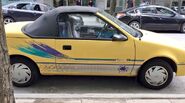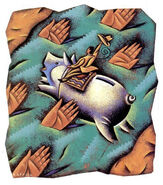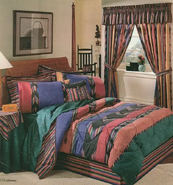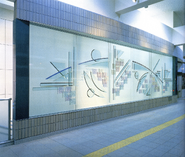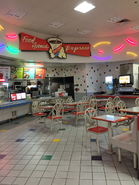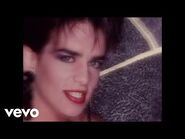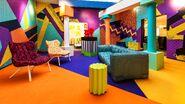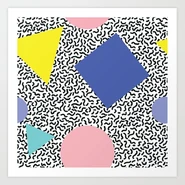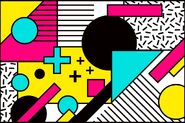Memphis Lite (or Contempo-Eclectic[1]) is the corporatized, more palatable direct evolution of Memphis Design that arose because the latter was poorly suited to incorporation into existing home designs. Coming to encompass graphic design and fashion more so than interior design, Memphis became the defining style of the 90s.
Memphis Lite's complete overshadowing of its parent in advertising, fashion and certain televisual works (such as game show sets) allowed Memphis Lite to supplant Memphis to the point that most Memphis revivals really harken to the Memphis lite aesthetic, a peculiarity most noticeable with the color palette stereotypical of Synthwave and Vaporwave.
History[]
Memphis Lite emerged in the 1980s as a diluted, consumer-grade iteration of the avant-garde Memphis Design movement. While true Memphis Design challenged traditional design norms with its bold colors, geometric shapes, and playful patterns, it was poorly suited to consumer products, and provided little thoughts in the real of graphic and fabric design. Memphis lite rapidly evolved to tone down the excesses of Memphis Design through less saturated colors and earthier palette and soon incorporated elements of both contemporary and previous aesthetics.
Notable borrowings include the chaotic arrangements and bold patterns of the Pacific Punk Wave, and Googie elements such as misaligned borders and distinct groups of overlapping abstract shapes separate by blank space. Memphis lite also introduced art deco and cubist figurative elements to an otherwise largely abstract design landscape. Other innovations of Memphis Lite include the "scribbly" and brushstroke motifs (as demonstrated by the iconic Jazz Cup design), illusory contours created by stippled or striped patterns forming shapes without outlines, and gradients, contrasting with Memphis' preference for flat colors and uninterrupted patterns.
The aesthetic peaked around 1988 to 1993 with Saved by the Bell, new jack swing's popularity, and the introduction of the jazz drinking cup style. During the early-mid-1990s, another aesthetic known as Global Village Coffeehouse became popular, overlapping with Memphis in some aspects. Grunge fashion also appeared during this time and mostly replaced Memphis Lite in fashion.
The Memphis Lite era ended around 1997 and was succeeded by the Y2K era, although some malls and commercial establishments continued to have this look until the 2010s, when they were redesigned in a Minimalist fashion. This aesthetic is often used to retroactively define and depict the '80s and Early '90s, via retrofuturism such as Synthwave, Vaporwave, and Future Funk.
Visuals[]
- Either of different palettes:
- Bold flat primaries
- Subdued or pastel colors
- CMYK shades, particularly the combination of of at least two of teal/aqua, pink/magenta and purple
- Irregular stippled patterns with dots, irregular dashes or other shapes like triangles
- Illusory contours from striped or stippled patterns
- Stippled gradients
- Misaligned Googie borders
- Solid drop shadows
- Two types of patterns:
- Busy, abstract patterns covering the entire planes (these were especially prominent in furniture design)
- Patterns composed of asymmetrical assemblages of shapes where each groups forms a separate unit on a flat or subdued pattern background (i.e. stipples)
- Outlined, typically rough-edged script fonts (Corporate Grunge influence?), often combined with a blockier font
- Art Deco-like combinations of dots, circles and lines
- Art Deco or cubist decorative pieces
- Heavy use of glass and chrome as a design element
- Abstract statement pieces combining all of the above in a cubic or abstract expressionist framework
Media[]
Interior design in sitcoms and movies continued to focus on the same aesthetics that Memphis failed to replace, reflecting the failure of Memphis Lite to impose itself in consumer interior design. Like its predecessor, Memphis Lite found much more success in commercial spaces like malls and stores and in set designs for talk or game shows. Advertisements also made large use of the aesthetic.
TV Shows[]
- Let's Make a Deal (1984-1986)
- Jem and the Holograms (1985-1988)
- Small Wonder (1985-1989, logo design)
- Bumper Stumpers (Canada, 1987-1990)
- Talk About (Canada, 1988-1990)
- Make the Grade (1989-1990)
- Saved by the Bell (1989-1993)
- Nickelodeon Arcade (1992)
- Adventures of Sonic the Hedgehog (1993–1996)
- Doug (1993-1999)
- Piment fort (Canada, 1993-2001)
- 4 et demi... (Canada, 1994-2001, credits/logo design)
- Friends (1994-2004, logo design only)
Movies[]
- Dirty Dancing (1987)
- Just Temporary (TV movie, 1989)
- The Sandlot (1993, logo design)
- Little Giants (1994, logo design)
- A Goofy Movie (1995)
- Digimon: The Movie (1999-2000)
- Zenon, Girl of the 21st Century (1999)
Music[]
- Paul Simon - "You can call me Al" (1986)
- Tiffany - "You and Me" (animated sequence in the Jetsons, 1997)
- Paula Abdul - "Opposites Attract" (1990)
















